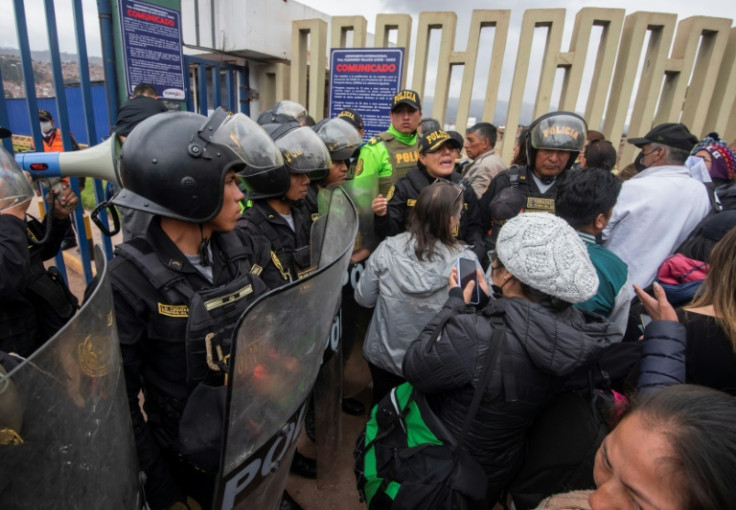Machu Picchu Evacuated After Protesters Sprayed With Tear Gas, Travel Advisories In Effect

Protests in Peru continue to intensify as demonstrators call for the removal of President Dina Boluarte. Protests calmed for two weeks but resumed in full force on Wednesday as demonstrators closed off street access to Congress and began striking across the country.
In December, almost two dozen protesters died in confrontations with police, and 700 were injured, according to the Peruvian newspaper La República. Demonstrators and activists have been calling for the removal of Boluarte, who became president last month after her predecessor Pedro Castillo was impeached and arrested for attempting to dissolve Congress and impose rule by decree.
France 24 reports protesters closed off major roads in southern and central parts of the country, primarily in Puno, Cusco, Apurimac and Arequipa, and Junin demanding Boluarte, the nation's first women president, to step down and for the country to hold early elections for the next president. On Dec. 14, Boluarte issued a state of emergency.
La República reports protesters have shut down 35 major roadways across the country, affecting 31 provinces, and the Peruvian National Police has launched tear gas at protesters in downtown Lima.
On Tuesday, 2,062 tourists visiting the ancient Incan city of Machu Picchu in southeastern Peru were evacuated from the area. The Ministry of Foreign Trade and Tourism released a statement on Wednesday addressing the evacuations and stating that multiple security agencies are working together to ensure the safety and protection of domestic and foreign tourists.
The press release said safe tourist corridors have been implemented to transport tourists out of the nation's historical sites and cities. Reuters reports trains to Machu Picchu are suspended until further notice.
Tourists were evacuated from Machu Picchu by helicopter on Dec. 19 after protesters blocked train routes in and out of the citadel to the city of Cusco with rocks The Guardian reports. Machu Picchu sits northwest of Cusco and is close to where the majority of the protests are taking place. The ancient Incan citadel is a UNESCO World Heritage site and one of the seven wonders of the world.

Several countries have listed travel advisories against visiting Peru as the protests and violence increase. On Wednesday, The Independent reported the UK Foreign Office had listed the Peruvian protests as "unpredictable," warning that the situation could escalate quickly and include violence.
The Canadian government issued a warning on Wednesday, calling for travelers to exercise a high degree of caution when traveling in the country and to avoid non-essential travel in and around Cusco and Machu Picchu. In addition, the United States issued a level three travel advisory for Peru on Dec. 22 due to crime and civil unrest.
Castillo was only in power for 18 months of a five-year term. A former school teacher and union activist from a small farming town in northern Peru. In December, The New York Times reported that Castillo based his platform around fighting for the rights of the poor and working class in rural communities.
Boluarte was Castillo's ally and First Vice President and was put in power after his ouster. Castillo is serving an 18-month pretrial detention while an investigation is conducted into allegations of corruption and planning a "rebellion," allegations the former president denies.
© Copyright IBTimes 2024. All rights reserved.




















